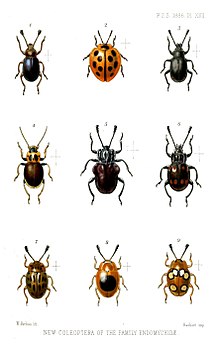Endomychidae
| Endomychidae Temporal range:
| |
|---|---|

| |
| Some handsome fungus beetles described in the 1880s | |
| Scientific classification | |
| Kingdom: | Animalia |
| Phylum: | Arthropoda |
| Class: | Insecta |
| Order: | Coleoptera |
| Suborder: | Polyphaga |
| Infraorder: | Cucujiformia |
| Superfamily: | Coccinelloidea |
| Family: | Endomychidae Leach, 1815 |
| Type genus | |
| Endomychus | |
| Synonyms | |
|
Agaricophilinae Lawrence, 1991 Merophysiidae Seidlitz, 1872 Mycetaeidae Jacquelin du Val, 1858 | |
Endomychidae, or handsome fungus beetles, is a family of beetles with representatives found in all biogeographic realms. There are around 120 genera and 1300 species. The family was established based on the type genus Endomychus, a genus erected in 1795 by Panzer which was applied to a species that Linnaeus called Chrysomela coccinea. As the common name suggests, Endomychidae feed on fungi. Crowson, in his influential treatment of the beetles, placed the family within the Cucujoidea. They have a tarsal formal of 4-4-4 or 3-3-3 and the wings lack a closed radial cell. The second antennal segment has a sensory appendage that is as long as the third antennal segment. The family has also been grouped with the Coccinellidae in a group called the Trimera for having pseudotrimerous tarsi.[1] A 2015 molecular phylogeny study found that the Cucujoidea were found to be non-monophyletic and the Endomychidae was refined with the removal of the Anamorphinae from within the family and elevated to the status of a full family, Anamorphidae. Mycetaeinae and Eupsilobiinae were also found not to belong within the clades of the core Endomychidae, and likewise reclassified into the families Mycetaeidae and Eupsilobiidae.[2]
The subfamilies that are included:
- Endomychinae (including )
- Epipocinae
- Leiestinae
- Lycoperdininae
- Merophysiinae
- Xenomycetinae
Genera[]
These 70 genera belong to the family Endomychidae as defined in the past (due to revisions, this may not be entirely accurate):
- Gerstaecker, 1858 g
- Reitter, 1904 g
- Motschulsky, 1838 g
- Germar, 1843 g
- Strohecker, 1964 g
- Costa, 1854 g
- Gerstaecker, 1858 i c g
- Aphorista Gorham, 1873 i c g b
- Strohecker, 1953 i c g
- Gorham, 1896 g
- Tomaszewska & Szawaryn, 2013 g
- Arrow, 1925 g
- Strohecker, 1971 g
- Arrow, 1943 g
- Gorham, 1888 g
- Arrow, 1920 g
- Strohecker, 1953 g
- Motschulsky, 1838 g
- Chondria Gorham, 1888 g
- Corynomalus Chevrolat in Dejean, 1836 i c g
- Mulsant, 1851 i g
- Danae Reiche, 1847 i c g b
- Tomaszewska, 1999 i c g
- Latreille, 1829 g
- Sasaji, 1970 g
- Gorham, 1891 g
- Shockley, 2006 g
- Reitter, 1877 g
- Gorham, 1888 g
- g
- Endomychus Panzer, 1795 i c g b
- Chevrolat in Dejean, 1836 i c g
- Epipocus Germar, 1843 i c g b
- Chevrolat in Dejean, 1836 i c g
- Gerstaecker, 1857 g
- g
- Eumorphus Weber, 1801 g
- Lea, 1922 g
- Shockley & Alekseev, 2014 g
- Hadromychus Bousquet & Leschen, 2002 i c g b
- Holoparamecus Curtis, 1833 i c g b
- Guerin, 1857 g
- Tomaszewska, 2012 g
- Blackburn, 1896 g
- Gerstaecker, 1858 g
- Leiestes Chevrolat, 1836 g
- Lycoperdina Latreille, 1807 i c g b
- Gerstaecker, 1857 g
- Lucas, 1852 g
- Wallaston, 1861 g
- Mycetina Mulsant, 1846 i c g b
- Strohecker, 1953 g
- Tomaszewska, 2011 g
- Chûjô, 1938 g
- Kirejtshuk & Nel, 2009 g
- Heller, 1916 g
- Arrow, 1920 g
- Phymaphora Newman, 1838 i c g b
- Motschoulsky, 1857 g
- Hampe, 1855 g
- Mulsant, 1846 g
- Arrow, 1920 g
- Rhanidea Strohecker, 1953 i c g b
- Saula Gerstaecker, 1858 i c g
- Strohecker & Chujo, 1970 g
- Stenotarsus Perty, 1832 i c g b
- Blaisdell, 1931 i c g
- Trochoideus Westwood, 1833 i c g b
- Gerstaecker, 1857 g
- Xenomycetes Horn, 1880 i c g b
Data sources: i = ITIS,[3] c = Catalogue of Life,[4] g = GBIF,[5] b = Bugguide.net[6]
Fossil genera[]
- Tomaszewska and Ślipiński, 2018[7] Burmese amber, Myanmar, Cenomanian
- Tomaszewska, Ślipiński and Ren, 2018[7] Burmese amber, Myanmar, Cenomanian
- Tomaszewska, Ślipiński, Bai and Zhang, 2018[7] Burmese amber, Myanmar, Cenomanian
- Tomaszewska, Ślipiński and Ren, 2018[7] Burmese amber, Myanmar, Cenomanian
- Tomaszewska, 2018[7] (replaced name Laima Alekseev and Tomaszewska, 2018): Baltic amber, Eocene
References[]
- ^ Tomaszewska, K.Wioletta (2000). "Morphology, phylogeny and classification of adult endomychidae (Coleoptera: Cucujoidea)" (PDF). Annales Zoologici. 50 (4): 449–558.
- ^ Robertson, James A; Ślipiński, Adam; Moulton, Matthew; Shockley, Floyd W; Giorgi, Adriano; Lord, Nathan P; McKenna, Duane D; Tomaszewska, Wioletta; Forrester, Juanita; Miller, Kelly B; Whiting, Michael F; McHugh, Joseph V (2015). "Phylogeny and classification of Cucujoidea and the recognition of a new superfamily Coccinelloidea (Coleoptera: Cucujiformia)" (PDF). Systematic Entomology. 40 (4): 745. doi:10.1111/syen.12138.
- ^ "Endomychidae Report". Integrated Taxonomic Information System. Retrieved 2018-05-07.
- ^ "Browse Endomychidae". Catalogue of Life. Retrieved 2018-05-07.
- ^ "Endomychidae". GBIF. Retrieved 2018-05-07.
- ^ "Endomychidae Family Information". BugGuide.net. Retrieved 2018-05-07.
- ^ a b c d e Tomaszewska, Wioletta; Ślipiński, Adam; Bai, Ming; Zhang, Weiwei; Ren, Dong (November 2018). "The oldest representatives of Endomychidae (Coleoptera: Coccinelloidea) from the Upper Cretaceous Burmese amber". Cretaceous Research. 91: 287–298. doi:10.1016/j.cretres.2018.07.001.
External links[]
- "Strohecker Collection — Amphix". University of Georgia. Archived from the original on 2010-06-10.
- "Endomychidae of Wisconsin". University of Wisconsin. Archived from the original on 2009-01-26. Retrieved 2009-02-13.
- Endomychidae
- Coccinelloidea
- Polyphaga families